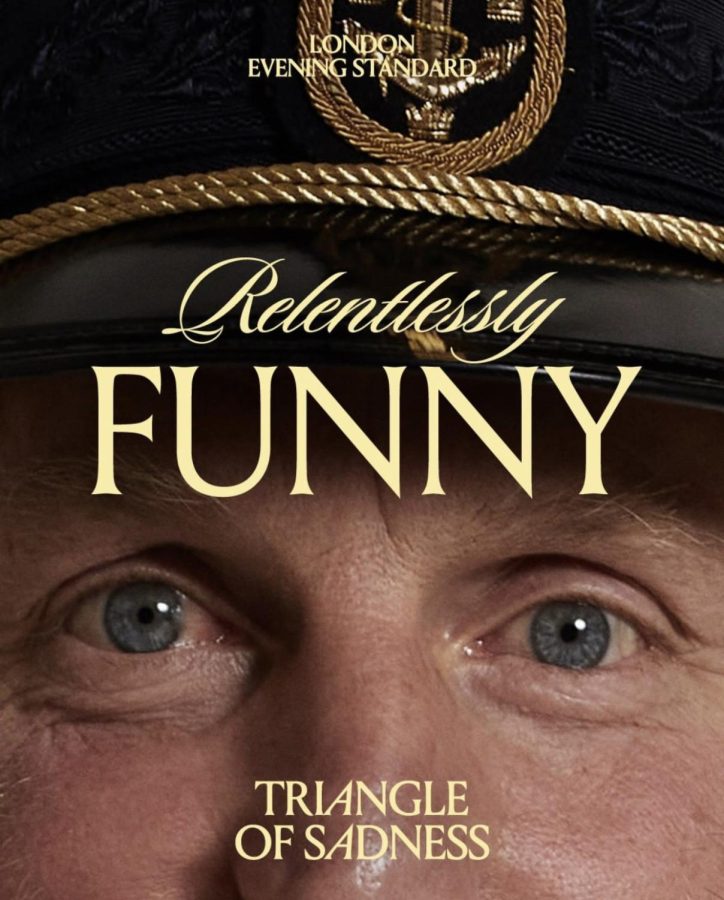‘Triangle of Sadness’ immerses viewers in a nauseating ride
October 16, 2022
Content warning: “Triangle of Sadness” may not be suitable for students with emetophobia.
The 2022 Palme d’Or winner, “Triangle of Sadness,” premiered at the New York Film Festival in all its disgusting glory, with the film’s colorful cast and surrealistic plot leading to an enthralling tale of the fall of the rich–even if it was a bit on the nose.
“Triangle of Sadness” follows Carl, a handsome yet insecure male model, and his girlfriend Yaya as they become passengers aboard a luxury yacht. The yacht is filled with social elitists, some passengers including a Russian CEO of a large fertilizer business, a lonely app coder and a gentle elderly couple known for designing the modern-day grenade. The ship is pushed along by a drunken Woody Harrelson, the Captain, who is also a self-identifying Marxist. “A Russian capitalist and an American communist!” Dimitry, the aforementioned CEO, observed on the boat. The Captain responded, “On a $250 million dollar luxury yacht!”
First and foremost, “Triangle of Sadness” is a satire. Director Ruben Östlund set up overarching themes from the very beginning, parodying wealth, social status and gender equality. Although these are topics that have been explored thoroughly in film before, Östlund’s witty writing and dry comedic moments bring these themes to light through the use of stupidly-rich characters to showcase the worst of these motifs. The Captain is used to portray the audience in the situation, as he was on the “outside looking in” while dealing with the requests that seem ridiculous to aware viewers, but necessary to the rich passengers.
Harrelson’s performance as the Captain is a great one; however, his character felt forced at times. Östlund used the Captain to polarize other characters, like Dimitry and spoke about his communist beliefs in a way that’s less than subtle. While it’s an interesting character trait, it would’ve been more impactful had it been subtle and then picked up by the climax of the film.
This film is about the fall of the wealthy, and Östlund didn’t hold back from witnessing the fall. This moment came during the Captain’s dinner that was taking place on a very stormy night. Serving nothing but chic and expensive seafood, the audience watched passengers gorge on their meals until each passenger experienced seasickness. The scene seemed to last forever as each passenger fell victim to their own body, vomiting on luxurious furniture and clothing. It’s a graphic and disgusting scene, yet so absurdly hilarious due to how uptight the guests were. Because of this scene, movie-goers were kindly given a gift at each theater before the film started: an official “Triangle of Sadness” vomit bag.
Östlund knows his way around the camera. He takes advantage of his environment and finds ways to convey a feeling that’s both claustrophobic and atmospheric. In this film, he utilized a night vision camera, which created a scary and paranoid aura. The camera is almost never steady on the boat, which nauseated and disoriented viewers. During scenes at the Captain’s dinner, the drunk Captain is shown at an angle almost the entire time. The long shots of the rocking boat along with disembodied voices of people screaming and vomiting are disturbing despite its elegance.
Although the themes are theatricalized in the film, Östlund’s political message is powerful. It’s rare to see a film let itself go and fall in a direction so humorous while keeping its serious message intact. “Triangle of Sadness” challenged important issues in a way that’s visually appealing as well as enticing with its intriguing cast of characters.














Alexia • Oct 19, 2022 at 1:45 pm
Wow! So we’ll written.
Can’t wait to go see it